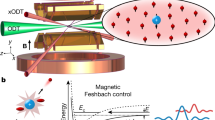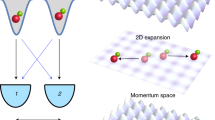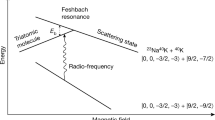Abstract
Atomic and molecular samples reduced to temperatures below one microkelvin, yet still in the gas phase, afford unprecedented energy resolution in probing and manipulating the interactions between their constituent particles. As a result of this resolution, atoms can be made to scatter resonantly on demand, through the precise control of a magnetic field1. For simple atoms, such as alkalis, scattering resonances are extremely well characterized2. However, ultracold physics is now poised to enter a new regime, where much more complex species can be cooled and studied, including magnetic lanthanide atoms and even molecules. For molecules, it has been speculated3,4 that a dense set of resonances in ultracold collision cross-sections will probably exhibit essentially random fluctuations, much as the observed energy spectra of nuclear scattering do5. According to the Bohigas–Giannoni–Schmit conjecture, such fluctuations would imply chaotic dynamics of the underlying classical motion driving the collision6,7,8. This would necessitate new ways of looking at the fundamental interactions in ultracold atomic and molecular systems, as well as perhaps new chaos-driven states of ultracold matter. Here we describe the experimental demonstration that random spectra are indeed found at ultralow temperatures. In the experiment, an ultracold gas of erbium atoms is shown to exhibit many Fano–Feshbach resonances, of the order of three per gauss for bosons. Analysis of their statistics verifies that their distribution of nearest-neighbour spacings is what one would expect from random matrix theory9. The density and statistics of these resonances are explained by fully quantum mechanical scattering calculations that locate their origin in the anisotropy of the atoms’ potential energy surface. Our results therefore reveal chaotic behaviour in the native interaction between ultracold atoms.
This is a preview of subscription content, access via your institution
Access options
Subscribe to this journal
Receive 51 print issues and online access
$199.00 per year
only $3.90 per issue
Buy this article
- Purchase on Springer Link
- Instant access to full article PDF
Prices may be subject to local taxes which are calculated during checkout




Similar content being viewed by others
References
Inouye, S. et al. Observation of Feshbach resonances in a Bose–Einstein condensate. Nature 392, 151–154 (1998)
Chin, C., Grimm, R., Julienne, P. S. & Tiesinga, E. Feshbach resonances in ultracold gases. Rev. Mod. Phys. 82, 1225–1286 (2010)
Mayle, M., Ruzic, B. P. & Bohn, J. L. Statistical aspects of ultracold resonant scattering. Phys. Rev. A 85, 062712 (2012)
Mayle, M., Quéméner, G., Ruzic, B. P. & Bohn, J. L. Scattering of ultracold molecules in the highly resonant regime. Phys. Rev. A 87, 012709 (2013)
Guhr, T., Müller-Groeling, A. & Weidenmüller, H. A. Random-matrix theories in quantum physics: common concepts. Phys. Rep. 299, 189–425 (1998)
Bohigas, O., Giannoni, M. J. & Schmit, C. Characterization of chaotic quantum spectra and universality of level fluctuation laws. Phys. Rev. Lett. 52, 1–4 (1984)
Weidenmüller, H. A. & Mitchell, G. E. Random matrices and chaos in nuclear physics: nuclear structure. Rev. Mod. Phys. 81, 539–589 (2009)
Mitchell, G. E., Richter, A. & Weidenmüller, H. A. Random matrices and chaos in nuclear physics: nuclear reactions. Rev. Mod. Phys. 82, 2845–2901 (2010)
Brody, T. A. A statistical measure for the repulsion of energy levels. Lett. N. Cim. Ser. 2 7, 482–484 (1973)
Lu, M., Burdick, N. Q., Youn, S. H. & Lev, B. L. Strongly dipolar Bose-Einstein condensate of dysprosium. Phys. Rev. Lett. 107, 190401 (2011)
Lu, M., Burdick, N. Q. & Lev, B. L. Quantum degenerate dipolar Fermi gas. Phys. Rev. Lett. 108, 215301 (2012)
Aikawa, K. et al. Bose-Einstein condensation of erbium. Phys. Rev. Lett. 108, 210401 (2012)
Aikawa, K. et al. Reaching Fermi degeneracy via universal dipolar scattering. Phys. Rev. Lett. 112, 010404 (2014)
Hancox, C. I., Doret, S. C., Hummon, M. T., Luo, L. & Doyle, J. M. Magnetic trapping of rare-earth atoms at millikelvin temperatures. Nature 431, 281–284 (2004)
Connolly, C. B., Au, Y. S., Doret, S. C., Ketterle, W. & Doyle, J. M. Large spin relaxation rates in trapped submerged-shell atoms. Phys. Rev. A 81, 010702 (2010)
Kokoouline, V., Santra, R. & Greene, C. H. Multichannel cold collisions between metastable Sr atoms. Phys. Rev. Lett. 90, 253201 (2003)
Krems, R. V., Groenenboom, G. C. & Dalgarno, A. Electronic interaction anisotropy between atoms in arbitrary angular momentum states. J. Phys. Chem. A 108, 8941–8948 (2004)
Petrov, A., Tiesinga, E. & Kotochigova, S. Anisotropy-induced Feshbach resonances in a quantum dipolar gas of highly magnetic atoms. Phys. Rev. Lett. 109, 103002 (2012)
Berninger, M. et al. Feshbach resonances, weakly bound molecular states, and coupled-channel potentials for cesium at high magnetic fields. Phys. Rev. A 87, 032517 (2013)
Takekoshi, T. et al. Towards the production of ultracold ground-state RbCs molecules: Feshbach resonances, weakly bound states, and the coupled-channel model. Phys. Rev. A 85, 032506 (2012)
Kotochigova, S., Levine, H. & Tupitsyn, I. Correlated relativistic calculation of the giant resonance in the Gd3+ absorption spectrum. Int. J. Quantum Chem. 65, 575–584 (1997)
Kramida, A. et al. NIST Atomic Spectra Database Version 5.0. http://www.nist.gov/pml/data/asd.cfm (2013)
Lawler, J. E., Wyart, J. & Den Hartog, E. A. Atomic transition probabilities of Er I. J. Phys. At. Mol. Opt. Phys. 43, 235001 (2010)
Gao, B. Zero-energy bound or quasibound states and their implications for diatomic systems with an asymptotic van der Waals interaction. Phys. Rev. A 62, 050702(R) (2000)
Wigner, E. P. On a class of analytic functions from the quantum theory of collisions. Ann. Math. 53, 36–67 (1951)
Dyson, F. J. & Mehta, M. L. Statistical theory of the energy levels of complex systems. IV. J. Math. Phys. 4, 701–712 (1963)
Alt, H. et al. Gaussian orthogonal ensemble statistics in a microwave stadium billiard with chaotic dynamics: Porter-Thomas distribution and algebraic decay of time correlations. Phys. Rev. Lett. 74, 62–65 (1995)
Taylor, J. An Introduction to Error Analysis: The Study of Uncertainties in Physical Measurements 272 (Univ. Science Books, 1997)
Brody, T. A. et al. Random-matrix physics: spectrum and strength fluctuations. Rev. Mod. Phys. 53, 385–479 (1981)
Gutzwiller, M. Chaos in Classical and Quantum Mechanics (Springer, 1990)
Frisch, A. et al. Narrow-line magneto-optical trap for erbium. Phys. Rev. A 85, 051401 (2012)
Watts, J. D., Gauss, J. & Bartlett, R. J. Coupled-cluster methods with noniterative triple excitations for restricted open-shell Hartree-Fock and other general single determinant reference functions: energies and analytical gradients. J. Chem. Phys. 98, 8718 (1993)
Oganesyan, V. & Huse, D. A. Localization of interacting fermions at high temperature. Phys. Rev. B 75, 155111 (2007)
Kollath, C., Roux, G., Biroli, G. & Läuchli, A. M. Statistical properties of the spectrum of the extended Bose-Hubbard model. J. Stat. Mech. 2010, P08011 (2010)
Acknowledgements
The Innsbruck group thanks R. Grimm for discussions and S. Baier, C. Ravensbergen and M. Brownnutt for reading the manuscript. S.K. and A.P. thank E. Tiesinga for discussions. J.L.B. is supported by an ARO MURI. The Innsbruck team is supported by the Austrian Science Fund (FWF) through a START grant under project no. Y479-N20 and by the European Research Council under project no. 259435. K.A. is supported within the Lise-Meitner program of the FWF. Research at Temple University is supported by AFOSR and NSF PHY-1308573.
Author information
Authors and Affiliations
Contributions
A.F., M.M., K.A. and F.F. did the experimental work and statistical analysis of the data. C.M., A.P. and S.K. did the theoretical work on coupled-channel calculations and RQDT. J.L.B. did the theoretical work on RMT. The manuscript was written with substantial contributions from all authors.
Corresponding author
Ethics declarations
Competing interests
The authors declare no competing financial interests.
Extended data figures and tables
Extended Data Figure 1 Fano–Feshbach spectrum of fermionic 167Er from 0 to 4.5 G.
The trap-loss spectroscopy is performed in an optically trapped sample of fermionic Er atoms at a temperature of 0.4TF, where TF = 1.0(1) μK is the Fermi temperature. The atoms are spin-polarized in the lowest Zeeman sublevel, mF = −19/2. We keep the atomic sample at the magnetic probing field for a holding time of 100 ms. We observe 115 resonances up to 4.5 G, which we take to be Fano–Feshbach resonances between identical fermions. The corresponding mean density is about 26 resonances per gauss.
Extended Data Figure 2 Elastic rate coefficient of mJ = −6 168Er collisions.
The s-wave elastic rate coefficient as a function of magnetic field assuming a collision energy of E = kB × (360 nK). Partial waves up to  = 20 are included. A divergence of the elastic rate coefficient, that is, the position of a Fano–Feshbach resonance, is marked with squares.
= 20 are included. A divergence of the elastic rate coefficient, that is, the position of a Fano–Feshbach resonance, is marked with squares.
Extended Data Figure 3 Statistical analysis of high-density Fano–Feshbach resonances of isotope 166Er.
a, Positions of the resonances are marked with vertical lines. b, The staircase function shows a similar behaviour to 168Er (Fig. 3). A linear fit to the data above 30 G is plotted in a lighter colour. From the staircase function, we calculate a mean density of resonances of  , which corresponds to a mean distance between resonances of
, which corresponds to a mean distance between resonances of  .
.
Extended Data Figure 4 NNS distribution and number variance.
a, 168Er NNS distribution above 30 G with a bin size of 140 mG. For the error bars we assume a Poisson counting error. The plot shows the experimental data (circles) with the corresponding Brody distribution (solid line). The parameter-free distributions PP (dashed line) and PWD (dash–dot line) are shown, and  for the Poisson distribution and
for the Poisson distribution and  for the W–D distribution. b, Number variance, Σ2, for the same experimental data (solid line) with a 2σ confidence band (shaded area). The number variance of the experimental data shows a clear deviation from the number variance of a Poisson distribution.
for the W–D distribution. b, Number variance, Σ2, for the same experimental data (solid line) with a 2σ confidence band (shaded area). The number variance of the experimental data shows a clear deviation from the number variance of a Poisson distribution.
Extended Data Figure 5 Density of resonances as a function of the magnetic field.
The densities of resonances for 168Er (a) and 166Er (b) are given as an averaged derivative of the staircase function (dark solid lines) using an averaging region 10 G in size. At small magnetic field values, the density of resonances is about 1.5 G−1, and it increases with the magnetic field up to about 30 G. For larger magnetic fields, the density is roughly constant. The staircase function also suggests this behaviour. From the data above 30 G, we calculate the mean value (light solid lines) and the standard deviation (light dotted lines) of the density of resonances.
Rights and permissions
About this article
Cite this article
Frisch, A., Mark, M., Aikawa, K. et al. Quantum chaos in ultracold collisions of gas-phase erbium atoms. Nature 507, 475–479 (2014). https://doi.org/10.1038/nature13137
Received:
Accepted:
Published:
Issue Date:
DOI: https://doi.org/10.1038/nature13137
This article is cited by
-
Bloch theorem dictated wave chaos in microcavity crystals
Light: Science & Applications (2023)
-
Developments in atomic control using ultracold magnetic lanthanides
Nature Physics (2021)
-
Tools for quantum simulation with ultracold atoms in optical lattices
Nature Reviews Physics (2020)
-
Phase protection of Fano-Feshbach resonances
Nature Communications (2020)
-
Clean numerical simulation: a new strategy to obtain reliable solutions of chaotic dynamic systems
Applied Mathematics and Mechanics (2018)
Comments
By submitting a comment you agree to abide by our Terms and Community Guidelines. If you find something abusive or that does not comply with our terms or guidelines please flag it as inappropriate.



